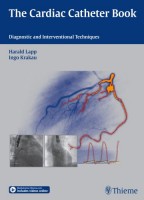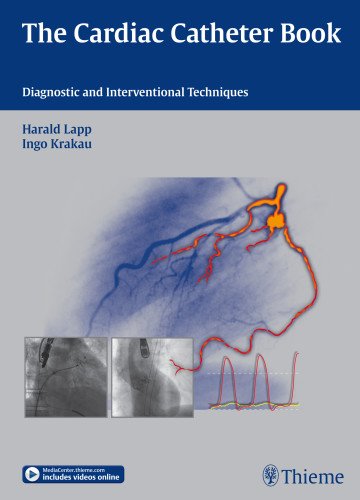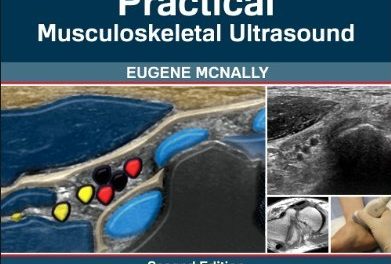 Authors: Harald Lapp, MD; and Ingo Krakau, MD
Authors: Harald Lapp, MD; and Ingo Krakau, MD
Publisher: Thieme – 416 pages, with 542 illustrations
Book Review by: Nano Khilnani
Cardiac catheterization involves passing a thin flexible tube (catheter) into the right or left side of the heart. The catheter is most often inserted from the groin or the arm.
The first step in this diagnostic procedure is for the health care provider to clean a site on the arm, neck, or groin of the patient, and insert an intravenous (IV) line into one of the veins. Second, a larger thin plastic tube called a sheath is placed into a vein or artery in the patient’s leg or arm. Then longer plastic tubes called catheters are carefully moved up into the heart using live x-rays as a guide. Then the doctor can:
- Collect blood samples from the heart
- Measure pressure and blood flow in the heart’s chambers and in the large arteries around the heart
- Measure the oxygen in different parts of your heart
- Examine the arteries of the heart
- Perform a biopsy on the heart muscle
- For some procedures, the patient may be injected with a dye that helps the doctor to visualize the structures and vessels within the heart.
The coverage of this book of nearly 550 pages is very extensive. In order to give you a good bird’s eye view of the subjects discussed and procedures shown in it, we present to you below the titles of its the chapters:
Diagnostic Cardiac Catheterization
- Indications for Diagnostic Cardiac Catheterization
- Risks and Complications
- Preparation for Cardiac Catheterization
- The Laboratory
- Interpretation and Findings
- Contrast Media
- Arterial and Venous Access
- Coronary Angiography
- Catheterization of the Cardiac Chambers
- Aortography
- Angiography of the Pulmonary Artery
- Hemodynamics
- Endomyocardial Biopsy
Cardiac Catheterization in the Diagnosis of Specific Diseases
- Valvular Disease
- Cardiomyopathies
- Coronary Artery Disease
- Pericardial Disease
- Aortic Dissection
- Congenital Heart Disease
- Acute Pulmonary Embolism
- Myocarditis
Interventional Cardiac Catheterization
- Percutaneous Coronary Intervention and Coronary Stent Implantation
- Percutaneous Coronary Intervention in Acute Coronary Syndrome
- Cutting Balloon Angioplasty
- Rotational Atherectomy
- Laser Angiography
- Thrombectomy and Protection Systems
- Peri- and Postinterventional Antithrombotic Therapy for Coronary Interventions
- Special Examination Techniques
- Percutaneous Cardiac Support Systems
- Heart Valve Interventions
- Occlusion of Septal Defects
- Other Interventional Techniques
- Percutaneous Retrieval of Foreign Bodies in the Cardiovascular System
Each of the three sections of this book is separated from the others with a cover page of a different color, and each chapter can be accessed by number at the edge of the book.
Except for a section in the end entitled Further Reading containing lists of books and other materials, each chapter is organized differently. No standard format is used in organizing the materials available in each chapter. However, there is ample use by the authors, of charts, illustrations, tables, text boxes, and x-rays, and an occasional photo.
Important matters pertaining to the subject of each chapter are discussed in a step-by-step, systematic manner. For example, chapter 14 on Valvular Disease guides the cardiology practitioner or student to correct diagnosis by providing discussion of these important considerations on several issues.
The first of these issues is Mitral Valve Stenosis, and the following considerations are taken up at from the beginning of this chapter:
- Anatomical and Pathophysiological Basics
- Specific Hemodynamics
- Pulmonary Circulation
- Indication
- Goal
- Procedure
- Special Considerations
- Findings on Cardiac Catheterization
- Interpretation of Findings and Patient Management
Here below are some key benefits of this book. It:
- Concisely reviews the basic of cardiac catheterization
- Covers the full range of interventional catheter techniques
- Examines current, evidence-based diagnostic approaches
- Describes key new interventions for structural heart disease
- Contains almost 600 illustrations including coronary angiograms
- Demonstrates step-by-step approaches, case studies, and detailed angiographic sequences in nearly 400 help videos available on www.MediaCenter.Thieme.com
As a purchaser of this book, you are entitled to electronic resources on the above-mentioned website, where you will find those resources for The Cardiac Catheter Book.
As you go to that site, when prompted during the registration process, enter the code found on the inside front cover of your copy of this book. The videos available to you online are on these subjects and procedures:
- Coronary Angiography
- Ventriculography
- Diseases of the aorta
- Pulmonary Angiography
- Endomyocardial Biopsy
- Valvular Heart Disease
- Cardiomyopathies
- Coronary Arterial Disease
- Pericardial Diseases
- Congenital Heart Disease
- Percutaneous Coronary Interventions (PCIs)
- PCI for Acute Coronary Syndrome
- Coronary Stent Implantation
- Rotational Stent Implantation
- Thrombectomy
- Percutaneous Cardiac Assist Device
- Percutaneous Valvular Interventions
- Percutaneous Occlusion of Septal Defects
- Percutaneous Extraction of Cardiovascular Foreign Bodies
- Cardiac Resynchronization Therapy
- Complications
This is a very valuable book made possible by:
Harald Lapp, MD is a Professor of Cardiology and Intensive Care Medicine at HELIOS Klinikum Erfurt in Erfurt, Germany.
Ingo Krakau, MD is a Professor of Cardiology and Intensive Care Medicine at HELIOS Klinikum Erfurt in Erfurt, Germany.







